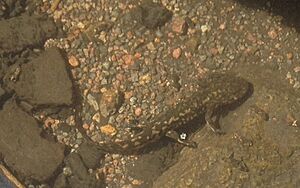Leora's stream salamander facts for kids
Quick facts for kids Leora's stream salamander |
|
|---|---|
 |
|
| Conservation status | |
| Scientific classification | |
| Genus: |
Ambystoma
|
| Species: |
leorae
|
| Synonyms | |
|
Rhyacosiredon leorae [1] |
|
The Leora's stream salamander, also called ajolote, is a very rare type of mole salamander. It belongs to a family of salamanders called Ambystomatidae. It lives only in a tiny part of Mexico, specifically in the Iztaccihuatl-Popocatepetl National Park. This park is on the border of the State of Mexico and Puebla. Scientists know of only one group of these salamanders left, and they live on Mount Tlaloc.
These salamanders need very clean water to survive. Sadly, their homes are threatened because people are taking water, cattle are grazing nearby, and in the past, people have hunted them for food. Because of these dangers, the Mexican government lists it as a threatened species. The International Union for Conservation of Nature (IUCN) calls it "critically endangered". This means it is very close to disappearing forever.
Where Does the Leora's Stream Salamander Live?
This special salamander lives only in the Sierra Nevada mountains in central Mexico. Long ago, it was found in six different places within the Iztaccihuatl-Popocatepetl National Park (IPNP). This park is located where the State of Mexico meets Puebla.
Sadly, the salamander disappeared from the Rio Frio area because the water became very polluted. Recently, in 2014, researchers found a new, small group of these salamanders. This might be the last group left. This group lives on Mount Tlaloc, which is close to Mexico City. Mexico City is one of the biggest and most crowded cities in the world.
What Kind of Home Does It Need?
Scientists found these salamanders in two small streams. These streams were about 2 meters (6.5 feet) wide and 6.5 meters (21 feet) deep. The water was cold, between 12 and 15 degrees Celsius (53-59°F). It also had a lot of oxygen, which is important for the salamanders.
The streams were surrounded by small grassy areas with plants like Muhlenbergia. There were also mountain forests with trees like Pinus hartwegii and Abies religiosa. Studies show that these salamanders have low genetic diversity. This means there isn't much variety in their genes. However, they do have high heterozygosity, which is a measure of genetic health. Scientists found three different genetic groups within this small area.
Why Is This Salamander in Danger?
The Leora's stream salamander is in big trouble. The IUCN says it is a critically endangered species. The Mexican government also lists it as threatened. This is because it lives in a very small area. Also, forests are being cut down, and the water it needs is getting polluted. People are also taking water for their own use.
Many things are changing the salamander's home. People are changing the streams to collect water for drinking. Cattle are being brought into the area, which can harm the environment. Also, in the past, some people collected these salamanders to eat them as traditional food. All these problems make it very hard for the Leora's stream salamander to survive.


